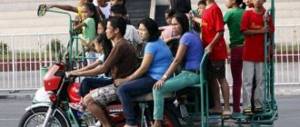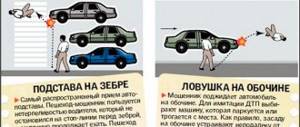- Amount of the fine and who must pay it
- In what cases is it considered that there is an extra passenger in the car?
- How to understand how many people can be transported in a car
- What are the dangers of carrying extra passengers?
- Examples of people overloading cars
- Tips on how to avoid overloading your car
If during a trip there are more people in a car than its technical characteristics allow, this is contrary to traffic regulations and is punishable by law. Violation is subject to administrative liability in accordance with Article No. 12.23 of the Administrative Code. In such cases, traffic police officers have the right to issue a fine for an extra passenger, as well as for several other points.
Amount of the fine and who must pay it
According to traffic rules, it is not allowed to transport people if their number exceeds the number of seats in the car. So, if a traffic police officer notices four passengers in the back seat of a car, he must issue a fine for the violation. Carrying an extra person will cost the driver 500 rubles (Article of the Administrative Code 12.23, clause 1).
But the total amount of penalties may be much higher. Previously, drivers paid only for the most “expensive” offense, but now the amounts of all penalties are added up if two or more violations are committed (Part 1 of Article 4.4 of the Administrative Code).
If there is an extra passenger in the car, then he lacks a seat belt. This is a separate offense, which is added to the main one and is assessed at 1000 rubles (Article 12.6 of the Administrative Code).
Sometimes in road practice there are fans of extreme trips when people are outside the cabin. For such dangerous movement, a third fine of 1,000 rubles is added to all of the above (Article 12.23 of the Administrative Code, Part 2).
All of the listed sanctions are imposed on the driver, since he is responsible for the life and health of his passengers. In addition, the unbelted passenger will also pay a fine, because violates clause 5.1 of the traffic rules, which obliges those in the car to use seat belts. The penalty will be 500 rubles (Part 1 of Article 12.29 of the Code of Administrative Offenses of the Russian Federation).
Basic rules for transporting passengers in cars
One of the key rules for transporting passengers in a car is a logical requirement. So, their number must certainly be equal to the number of seats. However, in practice, this requirement is often violated.
Who among us has not seen how, during a trip, there are six, or even more, people inside a car designed for five people (driver and four passengers). If the car is intended for transporting people on an intercity or tourist basis, then each of those traveling in it must be in their own seat and sit, but under no circumstances should they stand.
In what cases is it considered that there is an extra passenger in the car?
If there are more than 5 people in the car, then for an ordinary passenger car this is a violation of the rules. According to the traffic rules (clause 22.8), it is allowed to transport the number of people provided for by the technical characteristics of the vehicle. For a standard passenger car, this is five people, including the driver.
Even more stringent requirements are imposed on trucks, since violations threaten more serious consequences and can lead to the death of a large number of people on the road. Passengers can be transported in the cabin depending on the number of seats. It is allowed to put people in the back only if the requirements of clause 22 of the traffic rules are met. Otherwise, the fine will be 1000 rubles (Article 12.23 of the Code of Administrative Offenses of the Russian Federation, Part 2). The amount is fixed and does not change depending on the number of passengers.
A driver transporting people in the back of a truck will not be fined if all the following conditions are met (clause 22 of the traffic rules):
- the person driving has a driver’s license for the right to drive a category “C” or “C1” vehicle for at least 3 years;
- when transporting 8-16 people (including passengers in the cabin), a driver’s license for the right to drive a category “D” or “D1” vehicle is required;
- in case of transportation of more than 16 people, category “D” is required;
- the number of people transported cannot exceed the number of seats;
- the machine must be in good working order;
- a flatbed truck must be equipped with seats installed at a height of 30-50 cm from the floor and at least 30 cm from the top edge of the side.
- seats located along the rear or side boards must have reliable backs;
- Transporting children in the back is prohibited.
Depending on its technical capabilities, a bus has a certain number of seats and standing places. Information about this is posted in the salon. But there are situations when each passenger must be provided with a separate seat (clause 22.3 of the traffic rules). The rule applies:
- for intercity transportation;
- when driving in mountainous areas;
- when the bus is used to transport tourists and conduct excursions;
- when transporting children.
If the bus does not fall into these categories, then passengers can occupy standing places, but their number is also strictly regulated.
Penalties for exceeding the passenger limit
Significant changes have been made to the rules for transporting citizens, which all motorists need to become familiar with:
- The fine for transporting passengers in excess of the norm is collected from the driver, and not from the people, as was the case before.
- The amount of the fine for exceeding the permissible number of passengers by different types of vehicles is provided for in Art. 12.23 Code of Administrative Offences.
- The amount of the administrative fine is not affected by how many extra people were in the car - one or more. It has a fixed value. A motorist driving a passenger car will be subject to an administrative fine of 500 rubles. For transporting people in excess of the limit provided for in the technical passport, in a cargo van, motorcycle, outside the cabin of a car or tractor, as well as a cargo trailer, the driver will be charged an administrative fine in the amount of 1,000 rubles.
- When the driver or passenger is not wearing a seat belt, the motorist will be subject to an administrative fine of 1,000 rubles under Art. 12.6 Code of Administrative Offences.
If several traffic rules are violated, all fines are summed up. Previously, the rule was that only one fine was imposed, which was the largest of all the penalties provided for the offenses committed.
Punishment for overloading a bus
Cancellation of the decision on violation of the rules for transporting passengers.
General rules regarding the transportation of passengers apply to all vehicles, but there are still nuances for each specific type of transport.
The number of people on a bus traveling between cities, regions or countries, as well as on special tourist routes, especially in mountainous areas, must correspond to the number of seats.
On buses making long journeys, all people must sit in the seats corresponding to the purchased tickets, and luggage must be stored in a special compartment for the duration of the trip.
Citizens sitting next to the driver in seats with seat belts should use them in order not to receive a fine. The fact is that when a person does not fasten the seat belts that are on his seat, a fine is imposed on both the driver and the violator himself.
The permissible maximum number of passengers on buses operating regular routes over short distances is provided for by the technical conditions of transportation, which specify the number of seats and standing places.
The traffic police inspector has the right to count passengers and, if an extra person is found, to levy a fine.
Expert opinion
Sergey Aleksandrovich
An independent expert in the field of assessment after an accident, an experienced car lawyer.
Get free help!
. Dismiss
The fine for carrying an extra passenger on a bus is 500 rubles. More severe fines for violating the rules for transporting children on buses: the driver faces a penalty of 3,00 rubles, an official – 25,000 rubles, and a legal entity – 100,000 rubles.
For violations at night, even more severe punishment is provided: the driver will be fined 5,000 rubles or deprived of his license for 4-6 months, officials will be given an administrative fine of 50,000 rubles, and a legal entity will be fined 200,000 rubles.
Overload in minibuses
Overload is a violation of Art. 12.23 Code of Administrative Offences.
A fairly common question on various forums is what the fine is for transporting standing citizens in a minibus.
Minibuses transport people over short distances. Therefore, for transporting excess passengers, a minibus driver will be charged the same administrative fine as a bus driver plying a short-distance route. Its size is 500 rubles.
The number of seated people must correspond to the number of seats in the minibus. The maximum number of standing people is indicated in the Technical Conditions of Transportation and depends on the brand of transport.
Overloading a passenger car
The driver of a passenger car will be fined for violating the following rules for transporting passengers:
- If there are 6 people in a passenger car, and it is designed for five, then they will charge 500 rubles.
- For transporting passengers outside the car, for example, in the trunk or on the body, there is an administrative fine of 1,000 rubles.
- For not wearing a seat belt, an extra person will be fined 1,000 rubles.
Thus, a motorist will have to pay 1,500-2,000 rubles for transporting more people than provided for in the technical passport, and the accompanying violation associated with the lack of a seat belt.
How to understand how many people can be transported in a car
To determine the correct transportation of people, you should be guided by the following requirements.
- Passengers must be in the passenger compartment or in the back if there are equipped seats.
- If the car has seat belts not only in the front seats, but also in the rear seats, then each passenger must be fastened.
- Children under 12 years of age, in accordance with clause 22.9 of the traffic rules, are transported using seat belts (only from 7 years old), or specialized restraint devices that correspond to their weight and height, or other devices that allow the child to be fastened with seat belts.
- The number of people must comply with the technical regulations for a particular vehicle (some models belong to category B, but allow up to 7 people to be transported without violating the rules).
Many car models that are now noticeably outdated did not leave the factory equipped with seat belts in the rear seats. In this case, traffic police officers have no right to hold accountable for an unbelted passenger.
The driver is prohibited from transporting people in a trailer of any configuration, outside the passenger car (in the trunk, on the roof, on the hood), or in a towed car.
What does the fine consist of?
The penalty for transporting passengers in the cabin in excess of the norm is regulated by Article 12.23 of the Code of Administrative Offenses of the Russian Federation and is 500 rubles. The fine for overloading a passenger car with people transported outside the passenger compartment (trunk, hood, etc.) is 1,000 rubles.
Important! The amount of fines issued in accordance with Article 12.23 of the Code of Administrative Offenses does not depend on the number of passengers transported incorrectly, that is, for transporting four or five people in the back seat, the fine is the same.
Please note that the penalty for violating paragraph 8 of Article 22 of the Traffic Regulations is not limited to a fine. After all, the extra passenger carried in the rear is not wearing a seat belt, since the car simply does not have such an additional device. This means that the driver receives a punishment in accordance with Article 12.6 of the Code of Administrative Offenses, which imposes a fine of 1,000 rubles on the driver for an unfastened passenger.
Thus, the final amount of punishment could be:
- 1500 rubles for exceeding the limit of people on seats.
- 2000 rubles for incorrectly transporting passengers outside the vehicle
- 2500 rubles for transporting extra people simultaneously inside and outside the cabin.
Please note that if you are fined for having an extra person in the car, this does not mean that you can continue driving with overload; traffic police inspectors have every right to issue the order again, since the violation has not been eliminated.
From the video you will find out what fine a driver can expect for overloading a car:
What are the dangers of carrying extra passengers?
Exceeding the number of passengers is a risk to their life and health. In Russia, people often do not take road safety seriously enough. Some drivers neglect the rules for transporting people or securing children using special restraints.
But traffic rules are based on sad experience and are written based on the real situation on the road in order to prevent the death of citizens. It is important to remember and understand the following.
- An overcrowded car shifts its center of gravity, which makes maneuvering difficult. This increases the risk of skidding, accidents, and failure of car parts.
- Exceeding the established norm for passengers leads to an increase in braking distance.
- A crowded car takes longer to overtake. Sometimes drivers do not take this fact into account, which causes accidents on the highway.
- Passenger pressure on the rear doors can cause them to open and people to fall onto the road from the moving vehicle.
In addition, overloading passengers harms the car and leads to rapid wear of parts. The car may fail while driving due to excessive load on the rear suspension.
Examples of people overloading cars
Typically, an overload situation occurs when people travel on vacation. A common mistake is that the child is not allocated a separate seat. Ignoring the rules of transportation, some believe that 4 passenger seats are intended for adults, and children can be carried.
This is a misconception. According to the rules, each child must be allocated a separate seat in the cabin. Even if four children can easily fit in the back seat, such transportation will be a serious violation (Section 22.9 of the Traffic Regulations).











